Ever wondered how to create a living room that exudes calm, simplicity, and sophistication all at once? Modern Japandi style is taking the interior design world by storm, blending the minimalist elegance of Scandinavian design with the serene, natural aesthetic of Japanese decor. This harmonious fusion offers spaces that are not only beautiful but also thoughtfully designed to promote relaxation and mindfulness.
Its popularity lies in its ability to turn everyday living areas into tranquil retreats, perfect for unwinding after a busy day. In this article, you’ll discover a wealth of inspiring ideas and practical tips to transform your living room into a serene Japandi haven.
From choosing the right color palettes and furniture to incorporating natural materials and subtle decorative elements, we cover a variety of design strategies that balance modern style with traditional Zen influences. Whether you’re starting from scratch or refreshing your current space, these ideas will help you craft a calming, stylish environment you’ll love coming home to.
1. Embrace Neutral Color Palettes for Calm and Cohesion
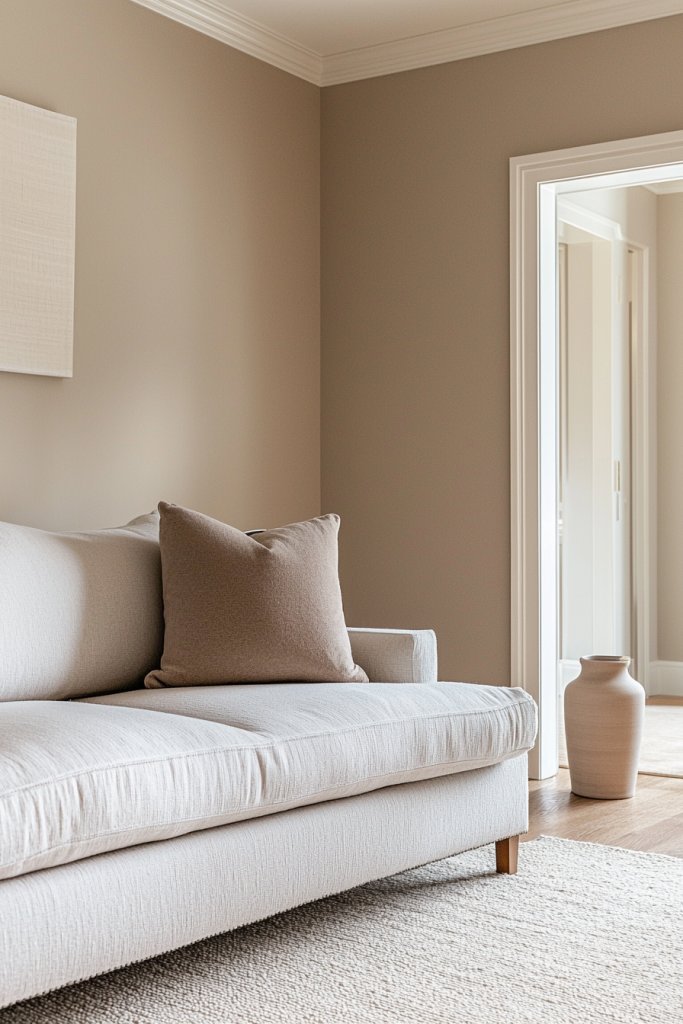
A neutral color palette is the backbone of a serene Japandi living room, creating a calming environment that feels both harmonious and effortlessly elegant. This approach uses soft, muted tones—think warm beiges, cool greys, creamy whites, and gentle taupes—that seamlessly blend together to foster a sense of tranquility.
These colors serve as a soothing backdrop, allowing natural materials and textures to stand out while maintaining visual cohesion across the space. Imagine a living room bathed in light, with walls painted in a warm oatmeal hue, complemented by a plush, light grey sofa and a soft cream rug.
Accents like a taupe throw pillow or a beige ceramic vase add subtle depth without disrupting the calm. The overall effect is a balanced, inviting space that feels open, uncluttered, and perfect for relaxation, whether you’re unwinding with a book or hosting friends.
The gentle, monochromatic tones evoke a sense of peace, making the room a true sanctuary. To recreate this look, start with a neutral wall color such as Benjamin Moore’s White Dove or Sherwin-Williams Accessible Beige.
Choose furniture in similar muted tones—think a low-profile sofa in light grey or beige, paired with natural wood or rattan accents. Incorporate textiles like linen throws or woven cushions in matching shades to add warmth and texture. Keep accessories minimal and cohesive, avoiding bright colors or busy patterns for a peaceful, unified environment.
2. Incorporate Minimalist Furniture with Clean Lines
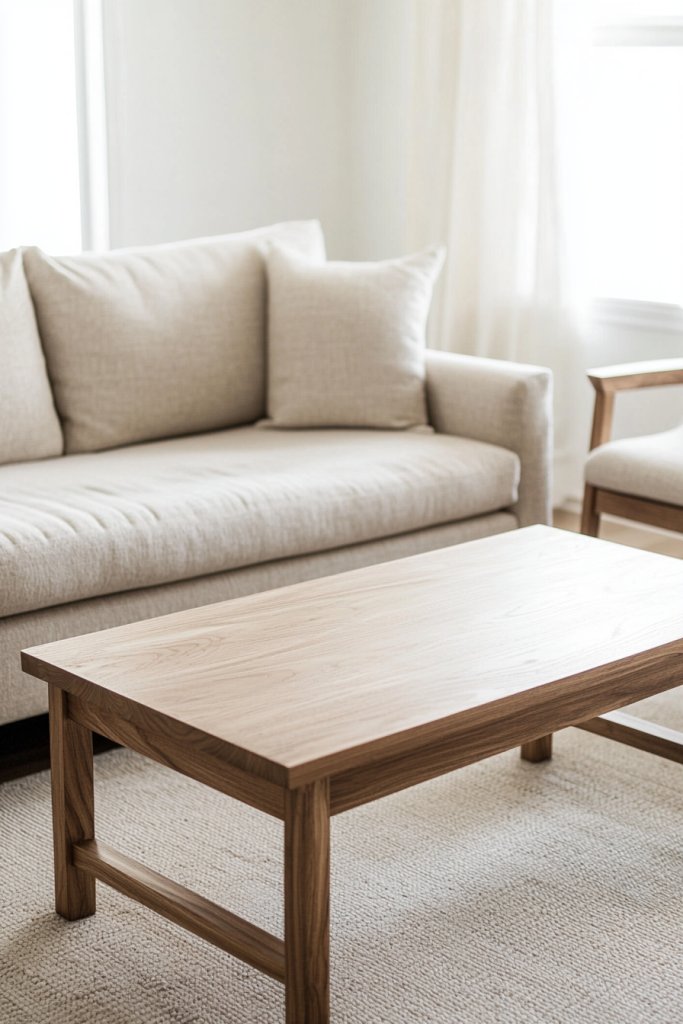
Minimalist furniture is essential in achieving the sleek, uncluttered aesthetic characteristic of Japandi style. Pieces with simple, geometric shapes and smooth, clean lines evoke a sense of order and calm, emphasizing functionality without sacrificing beauty.
This furniture often features natural wood finishes, showcasing craftsmanship while maintaining an understated elegance that complements the overall serene atmosphere. Picture a low-profile, solid wood coffee table with straight legs, paired with a streamlined sofa in neutral fabric.
The furniture is thoughtfully scaled to maintain openness—avoid bulky or overly ornate pieces—and instead opt for designs that breathe space. Barely-there armchairs with slim profiles and subtle detailing further enhance the minimalist vibe.
The overall arrangement encourages easy movement and visual flow, creating a balanced, harmonious room. To implement this, focus on selecting furniture characterized by simple, unadorned silhouettes—such as a Scandinavian-inspired oak sideboard or a sleek, upholstered sofa with slim arms.
Look for pieces with natural wood finishes or matte surfaces, which add warmth without visual clutter. For beginners, consider multifunctional furniture like a storage ottoman or a modular sofa system, which provides practicality and simplicity. Keep accessories minimal, allowing the furniture’s design to serve as the focal point.
3. Use Natural Materials Like Wood and Rattan for Warmth

Natural materials are at the heart of Japandi design, infusing the space with warmth, texture, and a sense of connection to nature. Light-colored woods—such as oak, ash, or maple—are favored for their understated beauty and durability.
Rattan and wicker add organic visual interest and a tactile element that invites touch, making the living room feel cozy and inviting. Visualize a coffee table made from smooth, pale oak with visible grain patterns, complemented by a rattan lounge chair with a soft cushion.
The scent of natural wood and woven fibers subtly fills the air, enhancing the calming atmosphere. These materials also add depth and texture, balancing the sleekness of minimalist furniture.
The combination creates a space that feels both modern and rooted in nature. To achieve this look, select furniture and decor in natural wood finishes or rattan—think a wooden media console, a woven basket, or a rattan pendant light.
For a budget-friendly option, visit thrift stores or furniture outlets for vintage or handcrafted pieces. Incorporate textiles like linen or cotton in neutral tones for upholstery and cushions, and consider adding a wool or jute rug for extra warmth. These materials are easy to source and maintain, making them ideal for a cozy, sustainable living room.
4. Opt for Low-Profile Sofas and Seating Arrangements
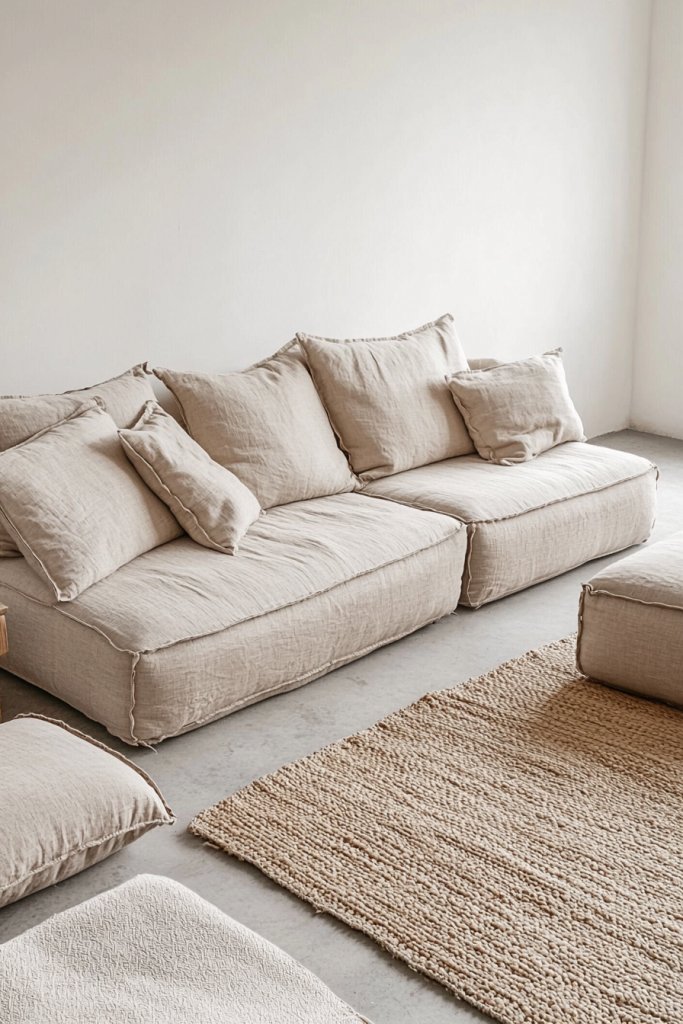
Low-profile seating is a hallmark of Japandi style, emphasizing a grounded, relaxed vibe that promotes a sense of calm and openness. These pieces sit close to the ground, often with slim legs or a platform base, creating a sleek silhouette that doesn’t overpower the space.
Such furniture encourages a laid-back atmosphere, perfect for lounging or intimate conversations. Envision a sofa with a low, wide seat upholstered in soft, neutral fabric, paired with a matching ottoman or floor cushions.
Surrounding the seating with a simple, natural fiber rug enhances the casual, inviting feel. The arrangement fosters a sense of space and ease, allowing for flexible layouts—whether you prefer a sectional or a pair of armchairs with a central table.
The overall look is effortlessly modern while maintaining a cozy, approachable vibe. To recreate this, choose low-profile sofas and chairs with clean lines in neutral fabrics like linen or cotton.
Look for designs with exposed wooden legs or a platform base—many brands offer minimalist options inspired by Scandinavian and Japanese aesthetics. For easy implementation, consider adding floor cushions or poufs for extra seating and versatility. Keep the surrounding decor simple to maintain focus on the seating’s sleek form and comfort, creating a relaxed yet stylish living area.
5. Add Textured Textiles in Cushions and Throws for Comfort
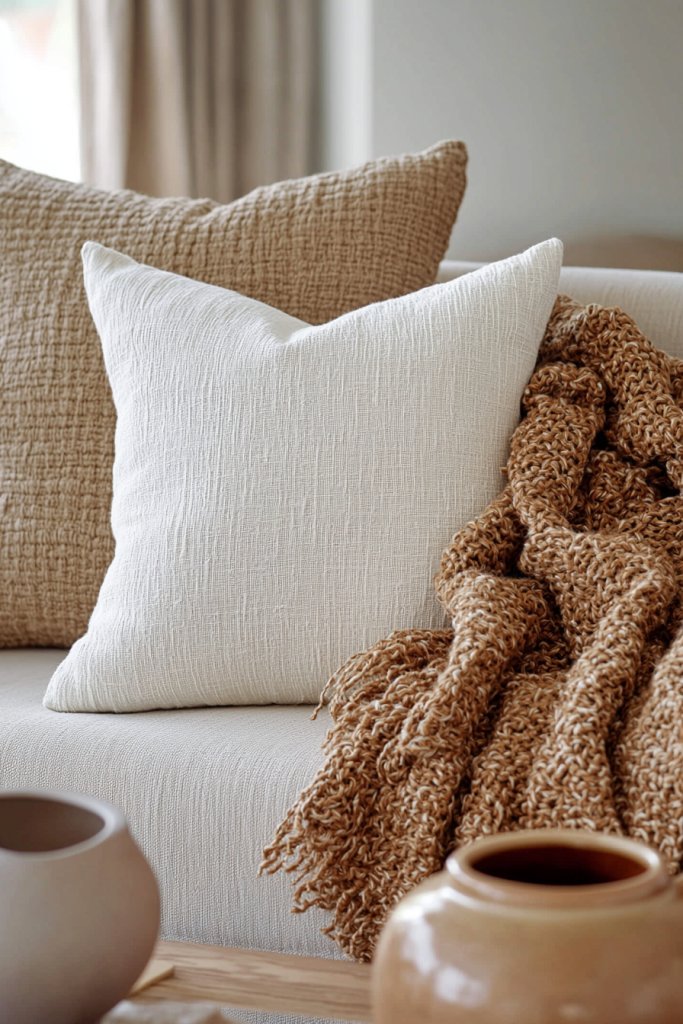
Textured textiles bring warmth, depth, and tactile interest to a Japandi living room, making the environment more inviting and comfortable. Cushions and throws crafted from natural fibers like linen, wool, or chunky knit yarn add visual softness and a sense of coziness, balancing the clean lines and minimalist furniture.
Imagine a soft cream linen cushion with a subtle weave pattern, complemented by a chunky wool throw in earthy tones draped over the sofa. These textiles invite touch and provide a sensory layer that enhances relaxation.
The textures contrast beautifully with smooth surfaces like ceramic vases or wooden furniture, creating a harmonious balance between sleekness and comfort. The overall effect is a space that feels thoughtfully curated yet effortlessly cozy.
To incorporate this, select cushions and throws in materials like linen, wool, or boucle, focusing on neutral or muted shades. Mix textures—such as a smooth cotton cushion paired with a chunky knit blanket—to add visual interest.
For easy access, look for ready-made options at home goods stores or craft your own from online tutorials. Layering these textiles not only elevates the aesthetic but also makes the space more tactile and welcoming, perfect for unwinding after a long day.
6. Incorporate Simple, Elegant Lighting Fixtures for Soft Ambiance

Creating a warm, inviting atmosphere in a Japandi living room hinges on lighting choices that diffuse soft, calming light. Elegant fixtures like minimalist pendant lights, sleek wall sconces, or understated table lamps can dramatically enhance the serenity of the space.
These fixtures should feature clean lines and subdued finishes—think matte black, brushed brass, or natural wood—to complement the overall aesthetic. Imagine a room softly illuminated by a low-hanging pendant with a simple, round paper or linen shade, casting a gentle glow that invites relaxation.
Alternatively, a pair of slim, wall-mounted sconces with hidden LED strips can provide ambient lighting without cluttering the visual flow. The key is avoiding harsh, direct light; instead, opt for fixtures that produce a warm, diffused glow that enhances the natural textures and neutral tones of the room.
The overall effect is a space that feels tranquil and cohesive, perfect for unwinding or quiet conversations. To achieve this, start by selecting lighting fixtures with minimalist designs that blend seamlessly with your decor.
Install a pendant or a pair of sconces at eye level or slightly above, ensuring they’re positioned to cast even, soft light across seating areas. Use warm LED bulbs or filament bulbs to enhance the cozy, inviting vibe.
Keep the wiring discreet and consider dimmer switches for adjustable mood lighting. Simple, elegant fixtures are easy to source from brands like Muuto or Menu, or from affordable options at IKEA or West Elm, making this a straightforward upgrade for your living space.
7. Utilize Hidden Storage Solutions to Maintain Clutter-Free Spaces

Maintaining the clean, uncluttered look of a Japandi living room relies heavily on smart storage solutions that keep everyday items out of sight. Hidden storage can be integrated into furniture pieces, such as ottomans with internal compartments, coffee tables with drawers, or wall-mounted units that blend seamlessly into the design.
This approach preserves the minimalist aesthetic while offering practicality. Picture a low-profile sofa with built-in storage beneath the cushions, or a sleek, organic-shaped coffee table with hidden drawers or compartments.
Behind the scenes, you might incorporate wall-mounted shelves with concealed cabinet doors or use furniture with integrated storage to hide blankets, magazines, or remote controls. These solutions ensure the space remains serene, with everything tidy and easily accessible when needed.
The goal is to eliminate visual clutter while maintaining a sense of order and calm. Start by assessing your most-used items and choosing furniture that doubles as storage—such as a storage ottoman or a media console with doors.
Use baskets or fabric bins inside drawers for smaller items, keeping them organized and out of sight. Opt for furniture in natural finishes like light oak or matte black to match the Japandi palette.
Installing wall cabinets or panels with hidden compartments can be an easy DIY project, and sourcing furniture with built-in storage from stores like CB2 or IKEA makes this both accessible and budget-friendly. The result is a peaceful, tidy environment that emphasizes simplicity and function.
8. Select Sleek, Functional Coffee Tables with Organic Shapes

A central piece in a Japandi living room, the coffee table, should combine sleek design with practicality, often featuring organic, rounded shapes that soften the space’s lines. These tables are typically crafted from natural materials like light wood, rattan, or stone, reflecting the harmony between form and function that defines Japandi style.
Visualize a coffee table with a smooth, curved silhouette, perhaps in pale oak or bleached walnut, sitting low to the ground and inviting touch. Its surface might be matte or lightly polished, with subtle grain patterns that add visual interest without overwhelming the space.
The organic shape creates a natural flow in the room, complementing the minimalist furniture and textured textiles. Some designs incorporate open shelving or hidden compartments for storage, enhancing their functionality while maintaining clean lines.
To recreate this look, choose a table with gentle curves and a natural finish—options are available from brands like HAY, Muuto, or from handmade artisans on Etsy. Keep the surface uncluttered, adding a few carefully selected decor pieces such as a ceramic tray or a small sculpture.
Ensure the size fits comfortably within your seating arrangement, leaving enough space for movement. Whether opting for a solid wood piece or a rattan design, the key is balancing sleek simplicity with organic charm, creating a versatile centerpiece that grounds your living room with understated elegance.
9. Decorate with Ceramic Vases and Sculptures for Subtle Elegance
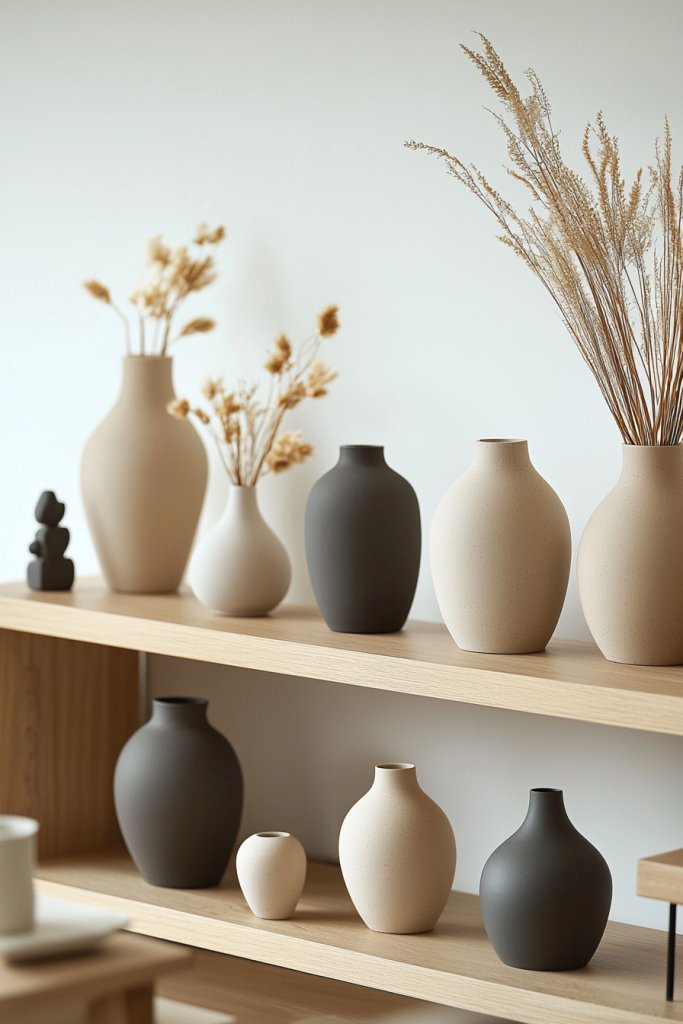
Ceramic vases and sculptures are essential decorative elements in a Japandi living room, adding a layer of subtle sophistication without disrupting the minimalist vibe. Their understated shapes and neutral tones serve as accent pieces that bring texture and visual interest while maintaining a calm, balanced aesthetic.
Envision a collection of handcrafted ceramic vases in muted earthy tones—soft beige, smoky gray, or matte black—placed atop open shelves, side tables, or the coffee table itself. These vases can be simple in form, with clean lines or gentle curves, perfect for holding dried flowers, wispy grasses, or standing alone as sculptural objects.
Small sculptures, perhaps inspired by Japanese or Scandinavian motifs, in matte finishes or natural clay, can also introduce a tactile element that elevates the space. The key is choosing pieces that are elegant yet unobtrusive, complementing the room’s neutral palette and natural textures.
To incorporate these elements, visit local ceramic studios or browse online shops like Nordic Nest or Etsy for handmade options. Select a few pieces with varying heights and finishes to create visual depth.
Arrange them thoughtfully on a sideboard, console, or coffee table, keeping the overall look uncluttered. You might also consider adding a single statement sculpture to anchor the space. This approach allows you to effortlessly elevate the room’s aesthetic, blending functional decor with artful simplicity that embodies the Japandi ethos of quiet elegance.
10. Use Sliding Doors or Screens to Create Flexible Living Areas
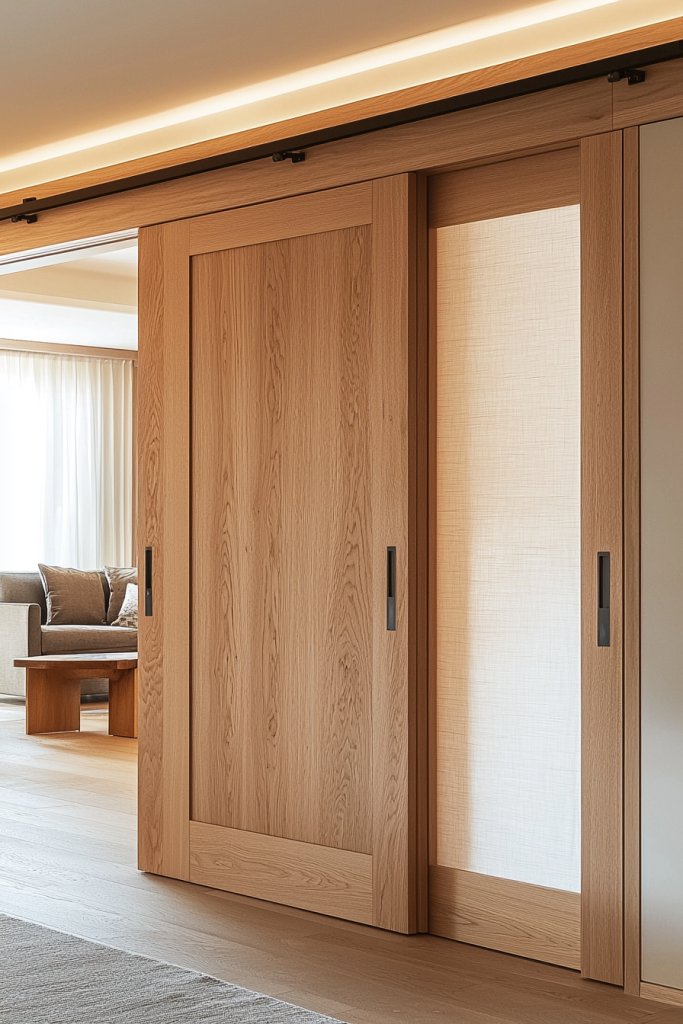
Sliding doors and screens are functional and aesthetic solutions that introduce versatility and privacy into a modern Japandi living room. Their clean, linear design aligns with the minimalist aesthetic while providing the flexibility to adapt the space for different uses or moods.
Imagine a pair of sleek, wooden sliding doors with simple, unobtrusive hardware, softly dividing a living area from an adjacent space when needed. Alternatively, a lightweight shoji screen with translucent paper panels or fabric offers a subtle, elegant way to partition the room, allowing light to filter through while creating a sense of separation.
These elements can be moved easily, transforming the space from an open, airy living room to a cozy, intimate setting in seconds. The visual effect is one of calm order, with natural materials and refined craftsmanship adding to the room’s serene atmosphere.
To implement this, look for sliding door systems in natural wood finishes, available at home improvement stores or specialty door suppliers. For screens, consider DIY options using lightweight frames and fabric or paper panels, which can be sourced from craft stores or online.
Installing sliding hardware is straightforward, and many kits come with clear instructions. Use these elements to subtly define zones for relaxing, dining, or working, ensuring the overall flow remains harmonious. This approach enhances functionality without sacrificing the minimalist, tranquil aesthetic that defines Japandi style.
11. Incorporate Japanese-Inspired Shoji Screens for Privacy and Style
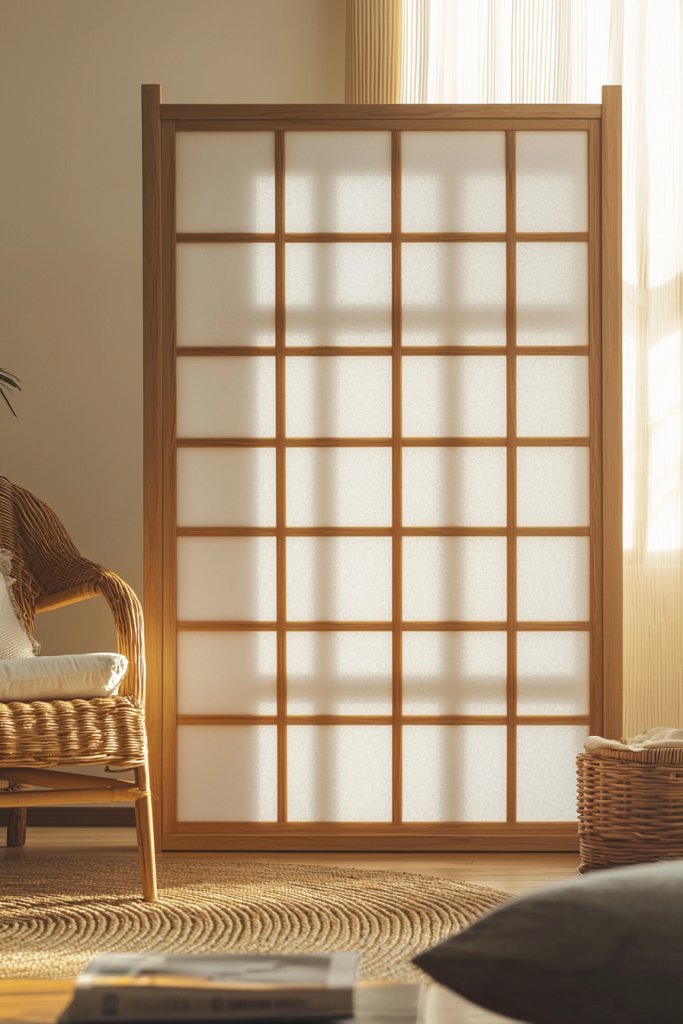
Adding Shoji screens to your living room instantly introduces a classic Japanese aesthetic while enhancing functionality. These lightweight, translucent panels are traditionally made with wooden frames and rice paper or modern fabric inserts, creating an airy, serene backdrop.
They serve as flexible room dividers, offering privacy without sacrificing openness, and their soft, diffused light adds a calming glow to the space. The natural wood tones of Shoji screens complement the warm, neutral palette typical of Japandi design, creating a harmonious blend of style and utility.
Imagine sliding a delicate, frosted panel to subtly partition your living area, allowing gentle sunlight to filter through the paper or fabric. The screens’ simple geometric grid pattern adds visual interest without overwhelming the space, and their light, natural wood finish pairs effortlessly with other elements like tatami mats or rattan furniture.
The overall effect is a tranquil environment that balances openness with privacy, fostering a peaceful retreat within your home. Their understated elegance makes them adaptable for various room sizes and layouts, fostering a minimalist yet functional aesthetic.
To incorporate Shoji screens, start by choosing a size that fits your space—whether a single panel or a multi-pane divider. You can purchase ready-made screens or DIY with a wooden frame kit and fabric or rice paper panels.
Install or position your screens along existing walls or doorways, ensuring smooth sliding for ease of use. For a budget-friendly option, repurpose existing room dividers with a wood finish and translucent fabric. The key is to keep the design simple and light, emphasizing natural materials and craftsmanship for maximum serenity and style.
12. Choose Monochromatic or Tonal Color Schemes for Serenity

A monochromatic or tonal color palette instantly creates a harmonious, peaceful atmosphere in a Japandi living room. By sticking to shades within the same color family—such as soft beiges, warm greys, or muted browns—you establish a seamless flow that feels both calming and cohesive.
This approach minimizes visual clutter and allows textures and materials to stand out, making the space feel more refined and intentional. The subtle variations in tone add depth and interest without disrupting the tranquil vibe.
Picture a room painted in a warm taupe or light grey, accented with cushions, throws, and decor in slightly darker or lighter shades of the same color. The textures of woven textiles, smooth ceramics, and matte woods all work together to evoke a sense of serenity.
The overall effect is a space that feels balanced and unified, where your eye effortlessly moves from one element to the next. This color strategy also makes it easier to update or change decor over time, as sticking to a core palette keeps everything visually harmonious.
To achieve this look, select a foundational color—such as soft beige or cool grey—and build your palette around it. Use paint, textiles, and decor items that share this hue but vary in texture and saturation.
Incorporate natural materials like linen, wool, and unfinished wood to enhance the layered, organic feel. Keep accessories minimal and avoid jarring contrasts; instead, add subtle variations in shade for visual interest. This simple yet effective approach creates a tranquil, cohesive space perfect for relaxation and reflection.
13. Integrate Modern Scandinavian-Inspired Accents for Balance

Blending Scandinavian design elements into a Japandi living room introduces a fresh, contemporary twist while maintaining the minimalist ethos. Think sleek, functional furniture with clean lines, paired with cozy textiles and warm wood tones.
Scandinavian accents—such as soft, chunky knit throws, geometric-patterned rugs, and simple ceramic vases—add a touch of hygge comfort and visual interest. This fusion creates a balanced, welcoming environment that feels both modern and serene.
Envision a low-profile sofa with tapered wooden legs, dressed with a textured cream throw and patterned cushions. A light-colored, geometric rug anchors the seating area, while a minimalist side table with a smooth finish complements the overall aesthetic.
Incorporate subtle metallic fixtures or modern lighting fixtures with clean shapes to add a touch of sophistication. The combination of Scandinavian simplicity and Japandi restraint results in a space that feels effortlessly stylish yet calming, appealing to contemporary tastes.
To incorporate these accents, select furniture with a Scandinavian silhouette—think tapered legs, rounded edges, and functional forms—and pair them with natural, muted textiles. Add a few decorative objects like woven baskets or ceramic bowls to enhance the layered look.
Keep the color palette neutral and avoid overly ornate details, focusing instead on quality, craftsmanship, and subtle contrasts. This blend of styles fosters a balanced, inviting living room that embodies modern elegance and tranquility.
14. Incorporate Built-In Shelving for a Seamless Storage Solution
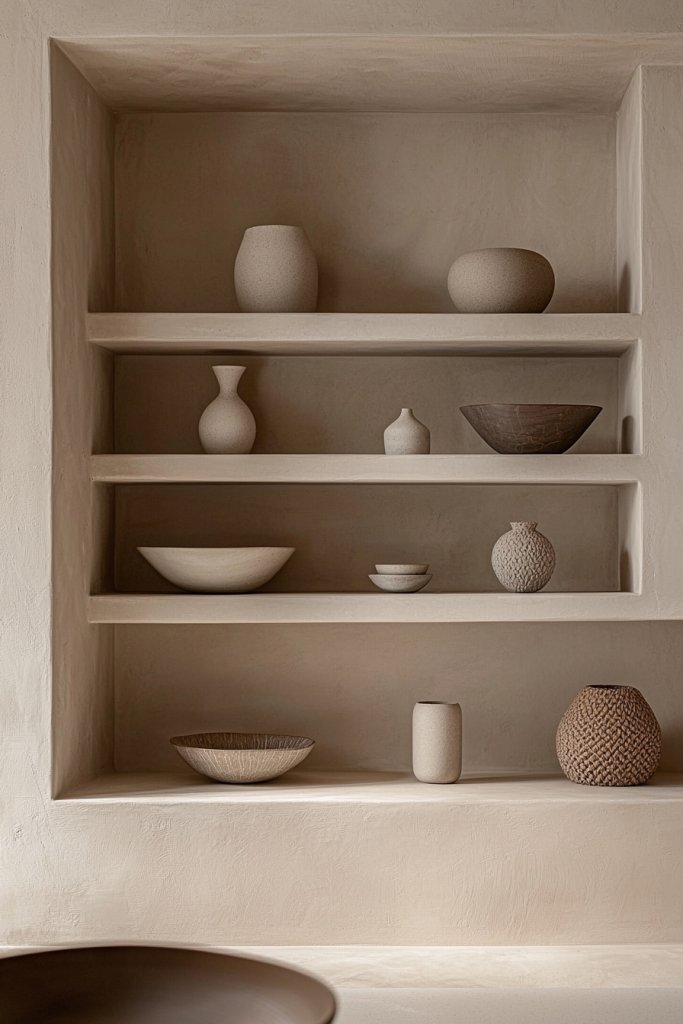
Built-in shelving is a smart, stylish way to maximize storage while maintaining the clean, uncluttered aesthetic of a Japandi living room. When designed thoughtfully, these shelves blend seamlessly into walls, creating a streamlined look that minimizes visual chaos.
Use natural wood finishes or painted in neutral tones to match or complement your overall color scheme. These shelves provide space for decorative ceramics, minimal books, or curated objects that add personality without clutter.
Visualize a wall with recessed shelving integrated into the architecture, showcasing a few carefully selected objects—such as simple vases, textured bowls, or small sculptures—arranged thoughtfully to evoke calm. The shelves’ subtle design ensures they don’t dominate the space but instead serve as an elegant backdrop that enhances the minimalist aesthetic.
Their strategic placement allows for easy access and display, helping you keep everyday essentials out of sight but within reach. This approach is perfect for small spaces or rooms prioritizing simplicity.
Start by planning your built-in shelving around your space’s dimensions, either consulting a carpenter or using modular systems for DIY projects. Choose materials like light wood or painted MDF that match your room’s color palette.
Keep the decor on the shelves minimal—stick to a few key pieces—and organize items to avoid overcrowding. Incorporate lighting within or above the shelves for added warmth and visual interest. With a little planning, built-in shelving can transform your living room into a serene, functional haven.
15. Use Mirror Elements to Maximize Light and Space

Mirrors are a powerful tool in a Japandi living room, instantly amplifying natural light and creating the illusion of more space. Opt for sleek, understated frames—such as slim black metal, matte wood, or frameless designs—that complement the minimalist aesthetic.
Large, horizontally oriented mirrors or a series of smaller mirrors arranged in a grid can reflect both light and the calming interior details, making the room feel brighter and more expansive. Imagine a tall, narrow mirror leaning against a wall or a large wall-mounted mirror positioned to catch sunlight from a window.
The reflective surface captures the soft neutrals and textures of your decor, enhancing the room’s tranquil atmosphere. The mirror’s subtle frame ensures it blends seamlessly with the clean lines and natural materials typical of Japandi style.
The effect is a space that feels open, airy, and harmonious, even if your room is modest in size. To incorporate mirrors successfully, choose a size and shape that fit your space—large enough to reflect key areas but proportionate to the room’s scale.
Position it opposite windows or light sources to maximize brightness. For added interest, consider framing the mirror with simple wood or metal trim, or opt for a frameless design for a more modern look. Regular cleaning and minimalistic placement keep the focus on creating a serene, expansive environment that’s both functional and beautiful.
16. Add Soft Rugs in Natural Fibers for Warmth Underfoot
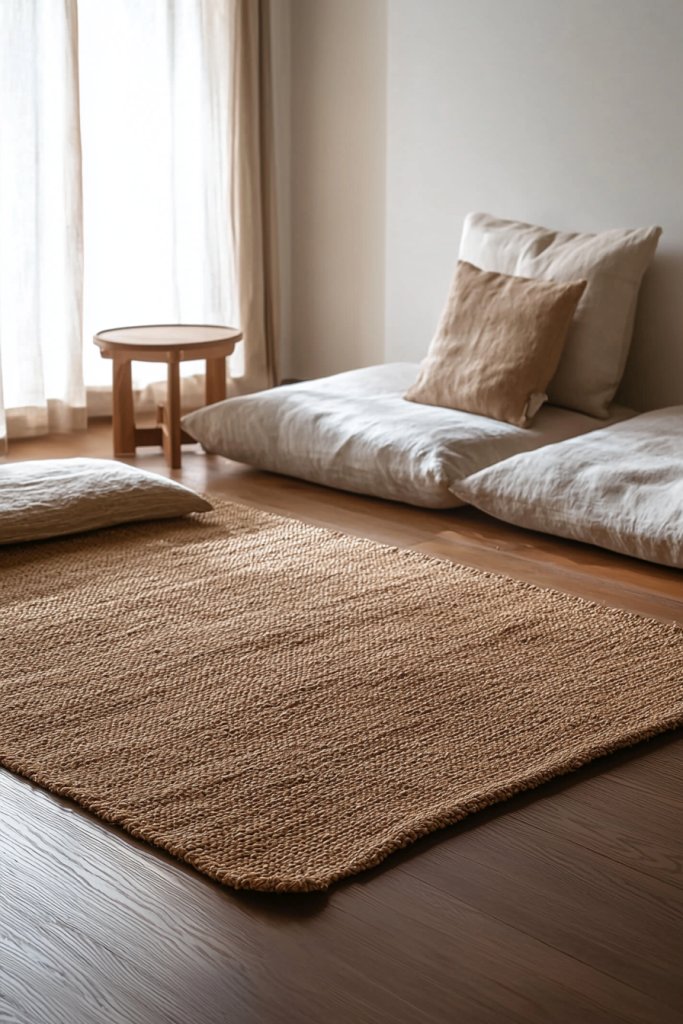
Creating a cozy, inviting living room starts from the ground up, and a soft rug made from natural fibers is the perfect finishing touch in a Japandi space. These rugs not only soften the hard surfaces but also introduce warmth and texture that complement the minimalist aesthetic.
Think of a plush, handwoven jute or sisal rug in neutral tones like warm beige, soft grey, or creamy ivory—these colors seamlessly blend with the overall calm palette. The tactile experience of walking barefoot on these fibers adds a sensory layer of comfort, while their organic look reinforces the natural, sustainable vibe central to Japandi design.
Visually, these rugs add a layer of visual interest without overwhelming the space. Their textured surface provides subtle depth against smooth wooden floors or sleek tiles, creating a cozy foundation for the furniture arrangement.
The fibers’ natural variations in color and weave pattern bring a handcrafted charm, making the room feel both serene and thoughtfully curated. When paired with a plush throw or cushions in muted tones, the entire space exudes warmth and understated elegance.
The smell of natural fibers—earthy and fresh—enhances the calming atmosphere, inviting you to settle in and unwind. To incorporate this idea, start by selecting a rug in a size that fits your space—typically a 5×8 or 6×9 foot works well for a living room.
Look for options in natural fibers like jute, sisal, or organic cotton, which are durable and eco-friendly. Lay the rug centrally under your seating area, ensuring enough space around the edges for a balanced look.
For added softness, layer a smaller, plush rug or add a textured throw blanket nearby. This simple addition can be achieved with minimal tools—just unroll, position, and enjoy the instant cozy upgrade.
17. Incorporate Textured Wall Panels or Wainscoting for Visual Interest
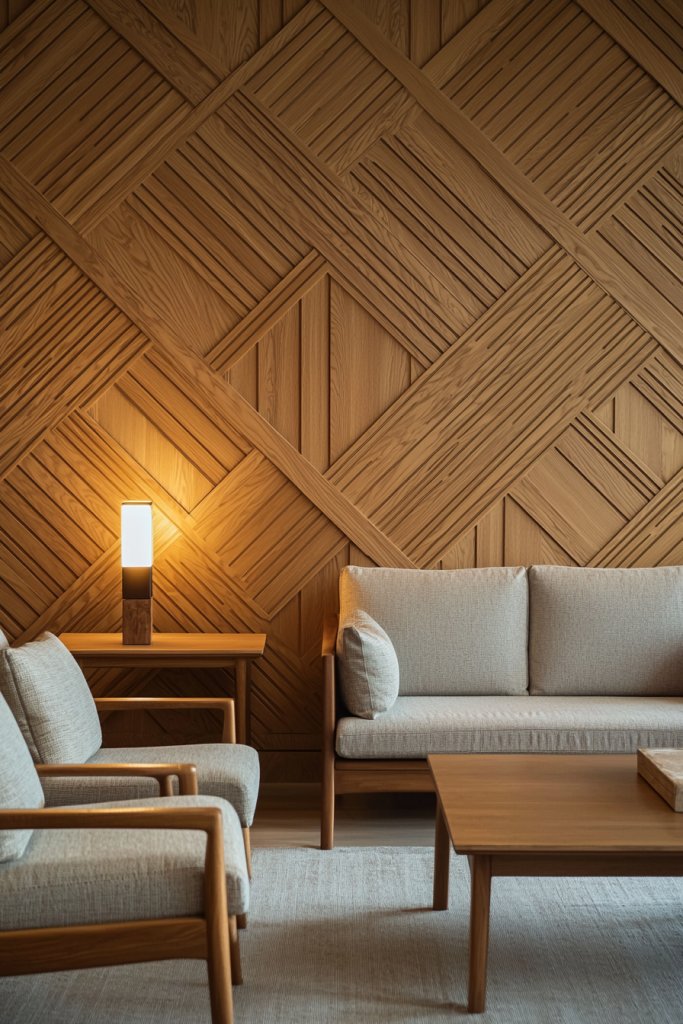
Adding textured wall panels or wainscoting elevates a Japandi living room by introducing subtle architectural detail that adds depth and sophistication. These panels—crafted from wood, bamboo, or MDF with a matte finish—offer a tactile contrast to smooth walls, creating a calming yet interesting visual focal point.
Opt for natural, neutral shades that match your color palette, such as light oak or soft grey, to maintain the serene atmosphere. The textured surface absorbs light softly, casting gentle shadows that enhance the room’s tranquility and bring a layered, handcrafted feel.
Visually, these wall treatments create a sense of refinement without clutter. The vertical or horizontal panels add linear rhythm, guiding the eye along the wall and making the space feel more structured yet still relaxed.
When paired with simple shelving or minimalist decor, they serve as a backdrop that emphasizes the room’s clean lines and natural materials. The textured surface invites touch, evoking a sense of warmth and craftsmanship.
In different lighting conditions, these panels subtly shift in tone, enriching the visual complexity of the space while remaining unobtrusive. To implement, measure your wall space and choose a panel style—wide planks for a rustic look or smaller, geometric shapes for a modern edge.
You can install wainscoting using basic tools like a drill, level, and adhesive or nails, following tutorials available online. Use pre-finished panels in natural wood or paint MDF panels in a neutral hue for a budget-friendly option.
Complete the look with a simple chair rail or molding at the top for a polished finish. This project is beginner-friendly and instantly adds texture and dimension to your living room walls.
18. Incorporate Functional yet Stylish Room Dividers
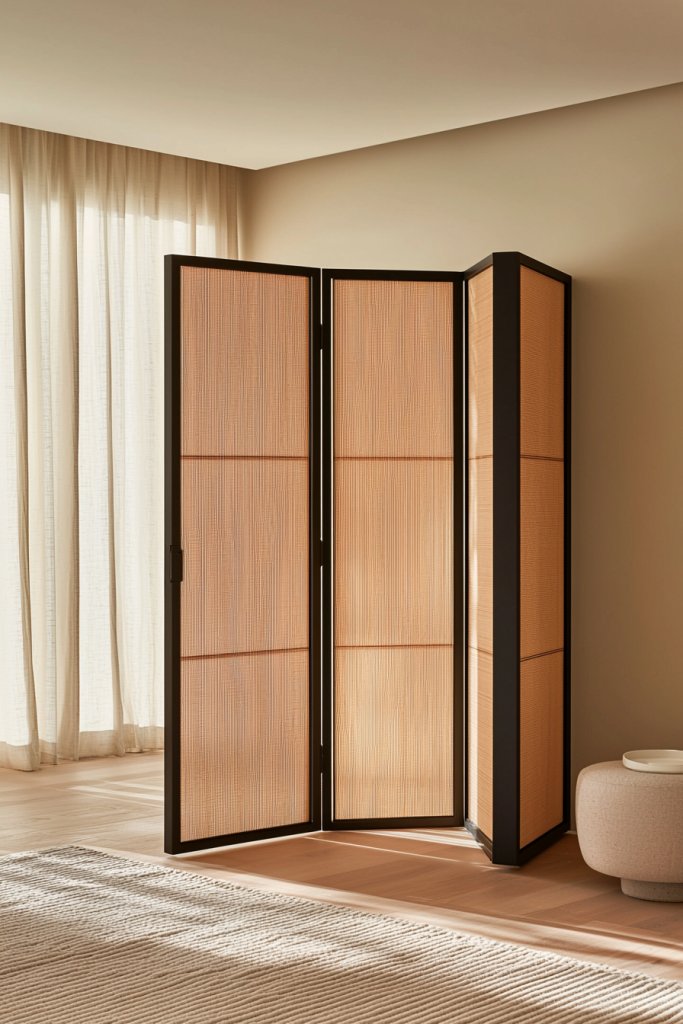
In a modern Japandi living room, clever room dividers serve dual purposes: defining spaces while enhancing the aesthetic. Opt for lightweight, minimalist options like sliding screens, open shelving units, or fabric curtains in neutral tones.
Materials such as bamboo, light wood, or woven rattan evoke natural simplicity, seamlessly blending function with style. These dividers create zones for different activities—like a cozy reading nook or a workspace—without sacrificing the open, airy feel typical of Japandi design.
Visually, room dividers add a subtle layer of separation that maintains flow and light. A bamboo slat screen, for example, allows glimpses of the other side while providing privacy and texture.
Open shelving units filled with curated decor, ceramics, or woven baskets act as both storage and visual boundary, adding interest with their vertical lines. Fabric curtains, in muted tones, soften the division, creating a gentle transition between zones.
The overall effect is a balanced, harmonious space that feels intentionally divided yet open and inviting. To implement, choose a divider style that suits your space—bamboo screens are easy to assemble, while open shelving can be custom-built or purchased ready-made.
Measure the area carefully to ensure proper fit and stability. For a DIY approach, repurpose existing furniture like a low bookcase or install a tension-mounted curtain rod with a neutral fabric curtain for a flexible solution. Keep the design simple and cohesive with your color scheme, and you’ll achieve functional separation that enhances your Japandi living room’s serene vibe with minimal effort.
19. Use Subtle Metallic Accents in Fixtures and Decor
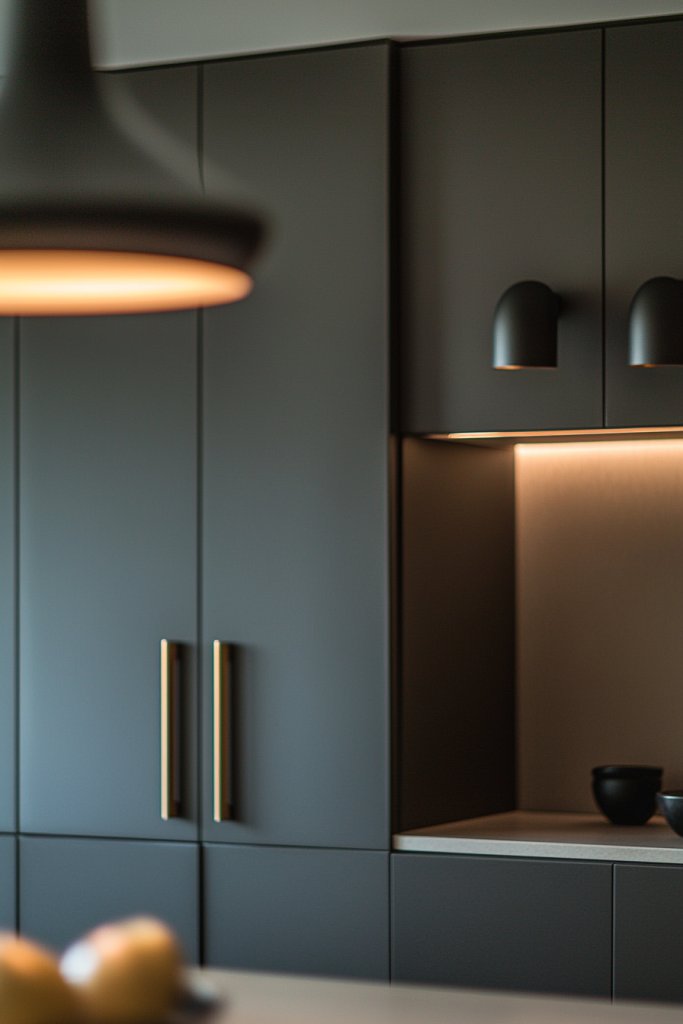
Adding touches of subtle metallics introduces a hint of understated elegance to your Japandi living room without overpowering the minimalist aesthetic. Think brushed brass, matte black, or soft gold in fixtures such as lighting, hardware, or decorative objects.
These accents catch the light gently and add visual interest while maintaining the room’s calm, refined tone. Small metallic details—like a minimalist lamp, decorative bowls, or picture frames—serve as focal points that elevate the overall design.
Visually, metallic accents create a sophisticated contrast against neutral backgrounds and natural materials. For example, a matte black floor lamp with sleek lines complements light wood furniture, while brushed brass vases or candleholders add warmth and shimmer to your tabletop or shelf display.
These subtle touches help define the space’s personality without clutter, adding just enough shine to keep the room lively and modern. The soft, muted finish of these metals harmonizes perfectly with the calm color palette typical of Japandi style, enhancing the sense of tranquility.
To incorporate, select a few key pieces—such as a lamp, hardware, or decorative objects—in your preferred metallic finish. Mix and match textures for visual depth, but keep the overall metallic presence subtle and cohesive.
You can find affordable options at home goods stores or repurpose existing items with metallic spray paint for a DIY upgrade. Position these accents thoughtfully around the room—on side tables, shelves, or as part of your lighting setup—to bring a refined, modern touch that complements the natural, minimalist aesthetic of your living space.
20. Highlight Architectural Details with Simple Molding or Trim

Enhancing your living room’s architecture with simple molding or trim is a subtle way to add character and depth, aligning perfectly with the clean, understated elegance of Japandi design. Thin, minimalist moldings—like a narrow crown molding or a sleek chair rail—can frame walls or ceilings, creating a sense of refinement without clutter.
Using natural wood or painted finishes in neutral shades ensures these details blend seamlessly into your serene space, enhancing architecture while maintaining simplicity. Visually, these trims define the room’s proportions and add a layer of visual interest without overwhelming the minimalist aesthetic.
The clean lines of subtle molding catch and reflect soft light, creating gentle shadows that add depth to the walls. When paired with textured wall panels or smooth, matte paint, they emphasize the minimalist elegance characteristic of Japandi interiors.
The overall effect is a space that feels thoughtfully finished and harmonious, with architectural details subtly elevating the design. To implement, measure your walls and choose a narrow molding profile that complements your ceilings and walls—wood or MDF painted in a light, neutral tone works well.
Attach the molding using a nail gun or strong adhesive, following tutorials for guidance. Keep the design simple: avoid ornate details or excessive layering. This straightforward upgrade is beginner-friendly and instantly enhances your living room’s architectural appeal, adding a touch of quiet sophistication that aligns with Japandi principles.
21. Incorporate Serene, Zen-Inspired Decor Elements for Tranquility
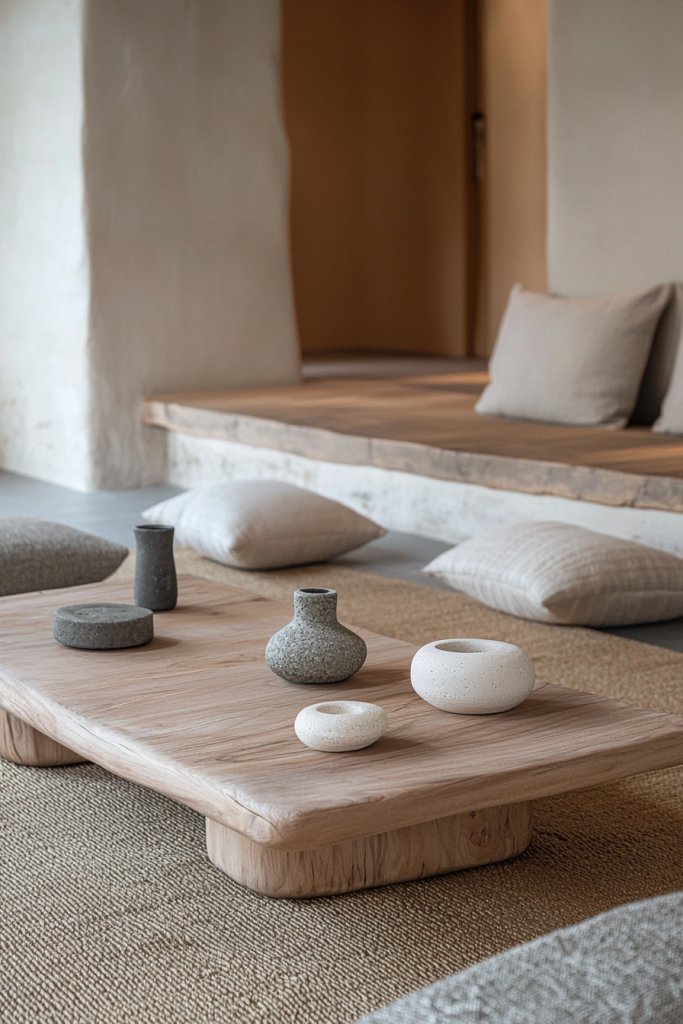
Creating a truly tranquil living space in the Japandi style involves integrating Zen-inspired decor elements that evoke a sense of calm and mindfulness. These subtle touches transform your living room into a peaceful retreat, emphasizing simplicity and harmony.
Incorporating these elements helps to foster a serene atmosphere that encourages relaxation and mental clarity, making your home feel like a sanctuary amidst busy modern life. Imagine a space where soft, neutral tones dominate, complemented by natural textures and minimal ornamentation.
You might include a small, smooth stone sculpture on a low wooden shelf or a simple, unadorned ceramic bowl that evokes a sense of balance. Incorporate elements like a Zen sand garden or a small, carefully curated collection of natural objects—such as driftwood or polished river stones—that add tactile interest without clutter.
The overall aesthetic is understated but thoughtfully curated, emphasizing open space, gentle lines, and a sense of order. The lighting is soft and diffused, often from paper lanterns or woven pendant fixtures, further enhancing the tranquil vibe.
To implement this concept, start with a few carefully chosen decor pieces that embody Zen principles—think minimalist sculptures, smooth stones, or calming ceramic ware. Use natural, muted colors like warm beiges, soft greys, or gentle browns to keep the palette cohesive.
Place these items on simple wooden or stone surfaces, avoiding overcrowding. Keep surfaces uncluttered and maintain a sense of balance by distributing decor evenly.
Finally, choose lighting that emits a warm, gentle glow—such as paper lanterns or dimmable fixtures—to complete the serene ambiance effortlessly. This approach makes your living room both visually calming and emotionally restorative.
Conclusion
Transform your living space with these inspiring Modern Japandi ideas, from embracing neutral palettes and minimalist furniture to incorporating natural materials and serene decor elements. Whether adding textured textiles, sleek storage solutions, or subtle metallic accents, each detail contributes to creating a calm, balanced environment.
Don’t hesitate to experiment with these concepts to craft a tranquil, stylish living room that truly reflects your personal serenity. Start today and turn your space into a sanctuary of modern simplicity and peaceful elegance.
Leave a Reply